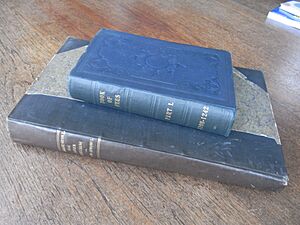Book of Fees facts for kids
The Book of Fees is the common name for a modern version of an old Latin book called the Liber Feodorum. This Latin name means 'Book of Fiefs'. A fief was a piece of land given by a king or lord in exchange for loyalty and service.
The original Liber Feodorum was put together around 1302. It was a collection of notes from 1198 to 1292. These notes listed lands held directly from the King, known as holding in capite (in-chief). The book helped the English Exchequer (like a government treasury) keep track of who owned what land and what they owed the King.
For a long time, people also called this book the Testa de Nevill. This name might have come from a picture of a "Nevill's Head" on the cover of one of the original collections. The modern "Book of Fees" was published in three volumes between 1920 and 1931. This version is much better and easier to use than older ones. Today, scholars use "Book of Fees" when they talk about this important historical record.
Contents
How the Book of Fees Started
Historians believe the documents that make up the "Book of Fees" came from two main collections of records:
The Testa de Nevill Collection
This first group of records dates back to the time of King John (1199–1216). It was known as the Testa de Nevill. The word testa in old Latin could mean 'head'. Historians think it might have been a container or a collection of documents marked with the head of an official named Nevill. Several officials named Nevill worked for the Exchequer in the 1200s. One important person was Ralph Neville, who was the chancellor.
The Robert Passelewe Collection
The second collection included records about "serjeanties". A serjeanty was a special type of landholding where people owed a specific service to the King, not just military service. These records were about lands that Robert Passelewe, a royal clerk and Bishop of Chichester, rented out during the reign of King Henry III. This collection also included information from inquiries made in 1255.
Creating the Liber Feodorum
Towards the end of King Edward I's rule (1272–1307), all these different documents were gathered into one large book. This book was for the Exchequer to use. It was officially called the Liber Feodorum.
We know it was created because a record from 1302 shows that John of Drokensford paid William of Coshall to copy the "book concerning fees" into two volumes. The book was bound that same year. It is now kept at The National Archives in the UK.
Why Was This Book Made?
One main reason for creating the Liber Feodorum was to help King Edward I collect a special tax called an "Aid". This Aid was for the marriage of his oldest daughter. The tax was based on lands held by knight service (military duty) or serjeanty (special services). The Exchequer needed a quick way to check who owed what. So, they gathered all the old records into one easy-to-use book.
A Reference Book, Not a Legal Record
It's important to know that the Liber Feodorum was meant to be a helpful reference book, not the official legal record itself. A note inside the book says that its contents were for "evidence" at the Exchequer, "and not for the record." This meant that if there was a legal dispute, the original documents were the true proof, not this copied book.
However, over time, many of the original documents were lost or damaged. So, the Liber Feodorum became the main source of information for the Exchequer.
Example from the Book

Here is an example of what you might find in the Testa de Nevill, along with its translation:
Norh'mpton: Feoda militum tenencium de domino rege in capite et tenencium de ipsis tenentibus de domino rege in capite et tenencium de wardis quae sunt in manu domini regis in comitatu Norht' propter scutagium eos quorum vera(?) tulerunt de habendum scutagium suis et propter feoda militum existencium infra balliam abbis burgi.
Feoda tenencium in capite de domino rege:
- Eustach de Watford tenet in WATFORD dimidium feodum
- Ricardus de Lindon tenet unum feodum in ESTON in comitatu NOR'HT et CASTR in comitatu ROTELAND et unum feodum in BUDENHO et BOESTON in comitatu BEDEFORD
- Gilbertus de Preston dimidium feodum in GRETTON per cartam regis Johannis et sicut in regno XII regis Edwardii filii rex Edwardii in Nor'ht
Translation:
"Northampton: Records of military tenants who held land directly from the King. Also, records of land held by those tenants from the King, and records of lands under the King's care in Northamptonshire. This was for collecting scutage (a tax instead of military service) from those who owed it, and for knight's fees within the area controlled by the Abbey of Northampton.
Knight's fees held directly from the King:
- Eustace de Watford holds half a fee in Watford.
- Richard de Lindon holds one fee in Eston in Northamptonshire and Castr in Rutland. He also holds one fee in Budenho and Boston in Bedford.
- Gilbert de Preston holds half a fee in Gretton, as stated in King John's charter, and as it was in the 12th year of King Edward's reign in Northamptonshire."
Modern Versions of the Book
Historians and researchers need accurate versions of old documents. Over the years, several modern editions of the Book of Fees have been published.
The 1920–31 Edition
Between 1920 and 1931, a new and much improved edition was published by the Public Record Office. This version came in three volumes. It was a big improvement because it arranged the information mostly by date, which made it much easier for scholars to use. It also corrected some mistakes from earlier copies and added missing information.
This 1920-31 edition is considered a very important and reliable guide for anyone studying medieval English history and land records.



